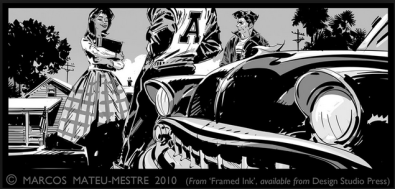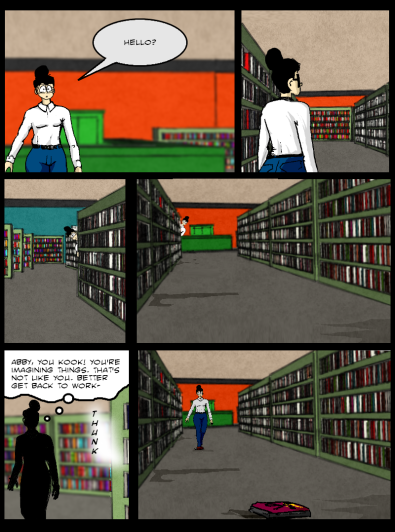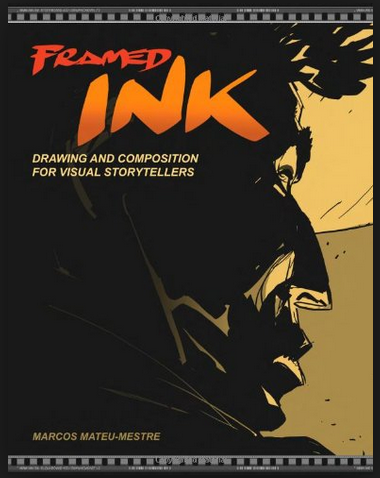
I just started reading a book called “Framed Ink” by Marcos Mateu-Mestre. I'm not that far in, but it's already incredible. It's a book about visual composition…comics! Or storyboards, or even animation.
What I like about it is the whole approach to art makes so much sense. He approaches his work first from the standpoint of MOOD. What is the overall mood of the story, and the mood/emotion of this particular scene, and of this particular panel or moment? Then he figures out the intensity of that emotion, and works from there. I'll have to keep reading to see what he says next.
This is what I already believed was the way to approach things. I'd never put it into words…or coherent thought, for that matter. It's all about emotion, mood, and telling the story. Very excited to read more and put some of this stuff into practice!
Honestly, I've given very little thought to mood or emotion in terms of the comic visuals.
I mean sure, I think about facial expression, dialogue and delivering a surprise or a joke, or the occasional tear-jerking moment…but to actually think about the emotion being delivered by the frames I'm drawing? Almost never.
The one exception was my comedy/horror special last Fall, “The Creepin' Willies”:
I knew I wanted this story to be tense and creepy at times, and that long shots and sometimes low angles were part of the horror/suspense visual vocabulary.
I was fairly pleased with how that issue turned out, actually, having reread it recently. A lot of my stories get a little wordy in spots, and there are too many “talking head” pages for my liking!
Putting more thought into the visuals has a lot of appeal. Hence the purchase of this book!
In any case, I'm still only a few pages in, but “Framed Ink” seems worthy of a shout out!
How about you? Do you think about mood and emotion with the art in your comics? How do you express it? How has it worked out so far?
Have a good one!
-Banes

Mood
Banes at 12:00AM, July 21, 2016
4 likes!


©2011 WOWIO, Inc. All Rights Reserved Mastodon





TheGhost at 1:44PM, July 22, 2016
This is one of my favorite books! It has a permanent place at my desk.
Ozoneocean at 8:44AM, July 22, 2016
I often like to set the mood of a scene visually. That's a huge part of the way I do things! Pacing, mood, emotion, I try to show all those things with my artwork.
bravo1102 at 11:55PM, July 21, 2016
Gone with the Wind. That is the film to read to understand mood.
bravo1102 at 11:43PM, July 21, 2016
I have been accused more than once with treating the panels in my comics like the frames of a film. Almost as if I understood the language of mood from my film studies. Want to understand mood? Study film noire. The next book I'm reading is a biography of William Cameron Menzies, the guy the credit of art director in a film was created for by David O. Selznik.
bravo1102 at 11:37PM, July 21, 2016
Hitchcock practiced setting mood with the contents of each frame. Ford could make you cheer or hiss based on the content of the frame. Hawks would tell you the relationships of the characters by where they were in the frame. A whole language of storytelling just by where and how something occupied a frame. And thenow there was light. Read Light and Shadows a history of motion pictures.
bravo1102 at 11:30PM, July 21, 2016
In college I minored in film studies. From Griffith to Ford, Hawks to Terrentino and so on. The composition of the frame sets the scene. A stage can be many frames and many sets each a Tableau upon itself. But the camera eye, like the artist's canvas puts it all in one frame like a painting. Everything can be in there and can totally be defined by the contents and how each is posed and lit. Even movement, what side to what side? Top to bottom, all have their meaning. It all creates mood. Mood is mise en scene especially in Film Noir.
ashtree house at 9:58PM, July 21, 2016
@Bravo1102- Yess, that was what they called it!
ashtree house at 9:58PM, July 21, 2016
I will have to check this book out! I went to film school (briefly, decided it wasn't the career for me, but worked on set for a bit afterwards), and framing is some of the first, basic things you learn in film making. Angles, color correction, close ups or plenty of space.. all of that plays a role in the emotion or mood you are trying to portray. However, I think it's still hard thing to do correctly. But if you pull if off, it adds a whole other level to the work!
bravo1102 at 6:17PM, July 21, 2016
It's all about the composition of the frame. Mise en scene as they say in film school.
Bruno Harm at 5:36AM, July 21, 2016
This is great! I really need to work on this. I think if I can make my comic more moody, the jokes will seem even more ridiculous.
Ironscarf at 4:35AM, July 21, 2016
If you're reading a book mood and tone all comes from the text. With comics we're dispensing with most of that, so it all has to be done with piccies! Fortunately a picture paints a thousands words as Telly Savalas used to say, so we're onto a winner. I usually start with thumbnails designed to tell the story clearly but even at this stage there are opportunities to choose angles, close ups, distance shots and framing to emphasize the mood. Once you get into the actual drawing, the possibilities are endless. I've just been planning one night scene where loads of shadow didn't seem to convey enough of the mood. Adding a stiff breeze did the trick: hair blowing in the wind, trees bending - use every film cliche in the book!
KimLuster at 4:33AM, July 21, 2016
I will have to get this book!! I've always tried to keep an eye toward mood, but it was largely guesswork when I attempted to convey it with perspective, angles, lighting and shadow...!! Great stuff again Sir!!
PaulEberhardt at 2:46AM, July 21, 2016
Mood and emotion are crucial. It's the part that makes artwork art and not just a mere drawing. To me, drawing is like making music (only with less noise). That's why I always try to leave some room for improvisation, more than readers might realise from the final result.